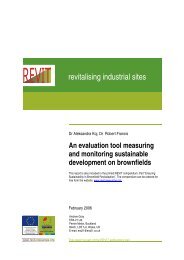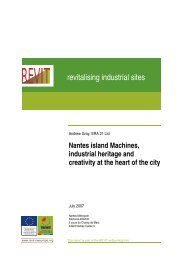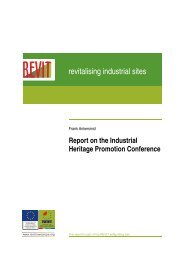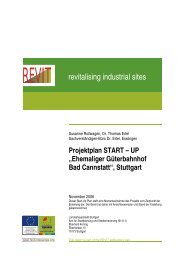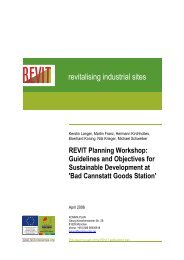REVIT Heritage Report.pdf
REVIT Heritage Report.pdf
REVIT Heritage Report.pdf
Create successful ePaper yourself
Turn your PDF publications into a flip-book with our unique Google optimized e-Paper software.
Torfaen County Borough Council<br />
<strong>REVIT</strong>: A Review of the Conservation of Industrial <strong>Heritage</strong> Assets on Brownfield Sites<br />
interconnected by railway tracks. Today, only small sections of façades and<br />
structures remain from the oldest buildings, mainly incorporated in later<br />
buildings.<br />
4.6.11 By the end of the nineteenth century the enormous growth of the complex had<br />
resulted in a site characterised by a number of extremely large productions<br />
halls, grouped around various production processes and centered on open<br />
spaces, some with walled enclosures and a porter's lodge at the entrance.<br />
The sites have a number of narrow industrial roads that are still typical for the<br />
site. The industrial site was organised around a wide railway track with<br />
branches accessing the factory halls via turntables and linked to the Stork port<br />
on the Twente canal, which dates from 1930. This site will form the focus of a<br />
complex of art studios, exhibition galleries, workshops, housing projects and<br />
catering businesses.<br />
4.6.12 The Stork brothers were active social reformers and one of their achievements<br />
was establishing, in 1914, the 'Het Lansink'which is a model workers'village,<br />
in the tradition of the English ‘garden villages’. The Lansink estate had large<br />
gardens with white washed houses forming terraces of no more than six<br />
dwellings with dormer windows and Dutch or stepped gables. The village, with<br />
its curving lanes, focused on a central square with houses, shops and a hotel<br />
arranged around the square. The pioneering social element was continued in<br />
the 'Vereenigingsgebouw'(Social Club) and the Wilhelmina school, where<br />
workers received in-house education and training.<br />
4.6.13 The Dikkers site dates from before 1910, when the two main buildings at<br />
Industriestraat, the iron foundry and accessory plant were built. The character<br />
of the site is maintained by similarity of the design of the main elevations with<br />
metal windows and iron structures infilled with which was 'characteristic'of<br />
their period and their function.<br />
4.6.14 At an early stage Hengelo took the important decision to seek statutory<br />
protection for the most historic buildings. The Wilhelmina school, which will<br />
house an industrial museum, the model-making plant and water tower, which<br />
has become a fire station, along with the Association Building were all<br />
designated as National Monuments. A number of other buildings have been<br />
designated or proposed for Communal Monument status. This ensures the<br />
most important structures will be preserved throughout the development<br />
process and the area’s character is retained.<br />
4.6.15 The quarter round the Stork building, near the station, defines the character of<br />
the city and forms part of Hengelo. One approach has been to maintain the<br />
site’s historic gird, which is formed by building plots and the railway lines that<br />
ran through the area. However, many of the buildings are large warehouses<br />
and are not considered suitable for residential use, unless the interior of the<br />
building was stripped and the façade maintained. Unfortunately this form of<br />
“facadism” would erode the historic character and integrity of the site.<br />
Future re-uses<br />
4.6.16 The development, named the New Stork City, aims to generate employment in<br />
the area with the neighbouring areas offering attractive environments for<br />
residents and businesses.<br />
4.6.17 Some of the new accommodation will be taken by the ROC-Oost Nederland, a<br />
regional educational centre and polytechnic, which is planning to set up a<br />
Community College with about 8,000 students in the area. Initially the<br />
vocational training department of the ROC will be accommodated in<br />
0014021/JM/001 37





